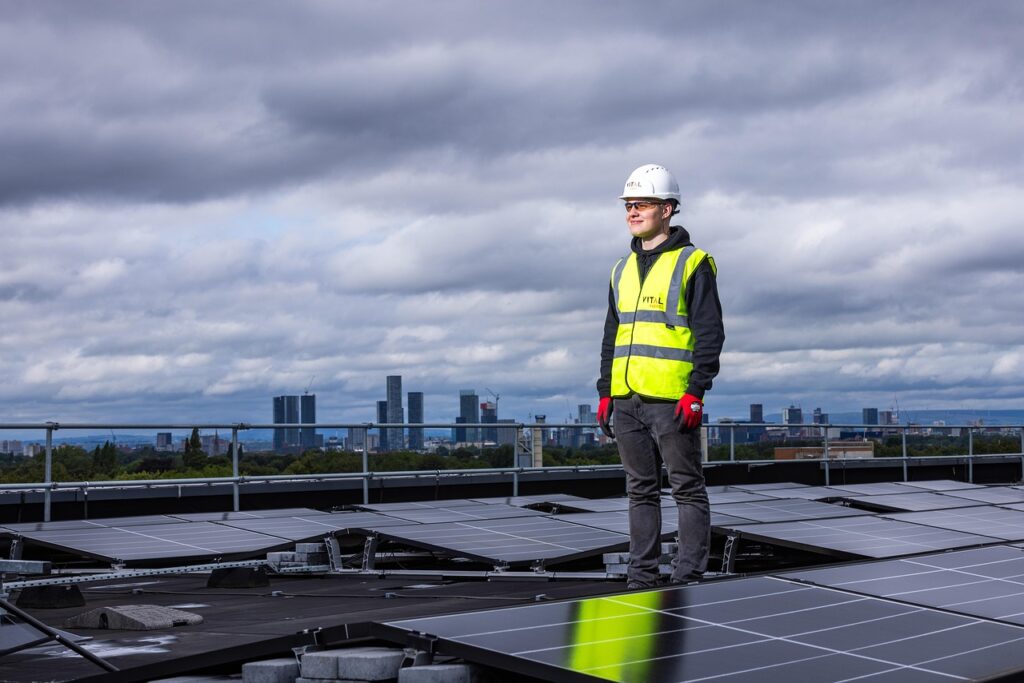A solar facade is an architectural feature that integrates photovoltaic panels directly into a building’s outer surface. It transforms exterior walls into energy-generating systems, allowing structures to produce clean electricity while maintaining their design aesthetics.
This technology offers a practical way to reduce reliance on traditional power sources by harnessing sunlight on vertical surfaces. It suits urban environments where roof space may be limited but sun exposure on facades remains significant.
By combining function and form, solar facades provide an efficient solution for modern energy demands. They are becoming a key component in sustainable building design and energy management strategies.
Solar Facade Fundamentals
Solar facades combine building design with solar energy technology to generate power directly from the building’s exterior. They vary by construction and function, requiring an understanding of their basic types and operational principles.
What Is a Solar Facade
A solar facade is an outer wall system integrated with solar energy components. It serves both as a building envelope and an energy generator. Unlike traditional solar panels, solar facades are part of a building’s architectural structure.
They maximize surface area available for capturing sunlight, especially in urban environments where rooftop space is limited. Solar facades contribute to energy efficiency by reducing the building’s reliance on external power sources.
Materials used include photovoltaic (PV) panels, solar thermal collectors, or hybrid systems. The system must balance aesthetics, energy performance, and weatherproofing.
Types of Solar Facades
There are three main types of solar facades:
- Photovoltaic (PV) Facades: Use solar cells to convert sunlight directly into electricity.
- Solar Thermal Facades: Capture heat for water or air heating applications.
- Hybrid Facades: Combine PV and thermal functions within one integrated system.
PV facades are the most common in commercial buildings due to their scalable electricity output. Thermal facades are selected mainly for heating needs but require integration with HVAC systems.
Hybrid facades optimize space and energy capture but need more complex design and control systems. Each type varies in cost, efficiency, and maintenance requirements.
How Solar Facades Work
Solar facades function by capturing sunlight hitting the building’s exterior. They convert solar radiation into usable energy, either electrical or thermal. PV cells convert photons into electrons through the photovoltaic effect.
In thermal facades, solar heat is absorbed by fluid-filled panels or air channels. This heat is then transferred into the building or stored for later use.
Energy output depends on factors such as panel orientation, shading, and climate conditions. Advanced designs incorporate tracking systems or adaptive shading to optimize energy capture.
Electricity generated by PV facades can power the building or feed excess into the grid, improving sustainability and reducing utility costs.
Benefits, Design, and Applications
Solar facades offer significant advantages in energy efficiency and sustainability, requiring careful design to optimize performance. Their integration affects aesthetics and building function, supporting varied applications in commercial and residential architecture.
Advantages of Solar Facades
Solar facades reduce electricity consumption by generating renewable energy on-site. They help lower carbon footprints and can contribute to building energy certification, like LEED or BREEAM.
Besides energy production, solar facades provide shading that decreases cooling loads, improving indoor comfort. They also offer insulation benefits, reducing heating demands in colder climates.
Financially, they can decrease operational costs through energy savings and potentially generate income via feed-in tariffs or net metering. Maintenance is relatively low compared to traditional energy systems, enhancing long-term value.
Design Considerations
Design of solar facades hinges on factors like orientation, solar irradiance, and climate. South-facing facades typically capture the most sunlight in the northern hemisphere.
Material selection affects efficiency; options include crystalline silicon or thin-film photovoltaic cells. Designers must balance transparency and energy generation, especially for curtain wall systems.
Integration with building systems is crucial. Electrical wiring, inverter placement, and thermal management should align with architectural features to maintain performance and safety. Regulatory compliance also guides design decisions.
Architectural Integration
Solar facades transform from purely functional elements into integral architectural features. They allow for creative expression through variations in color, texture, and pattern.
Designers can blend photovoltaics with glass, metal panels, or shading devices without compromising aesthetics. Modules may be semi-transparent to preserve daylight while generating power.
Structural load and building codes influence installation methods. When well executed, solar facades enhance visual appeal and demonstrate environmental responsibility, elevating a building’s market value.
Common Use Cases
Solar facades are common in commercial office buildings, universities, and government facilities aiming for sustainability goals. These locations benefit from large surface areas and predictable energy use.
In residential settings, solar facades suit multi-family housing where roof space is limited. Mixed-use developments often combine solar facades with rooftop panels.
Urban environments use them to reduce dependency on grid power and improve air quality. Retrofitting existing buildings with solar facades is an emerging trend to increase renewable energy adoption.
